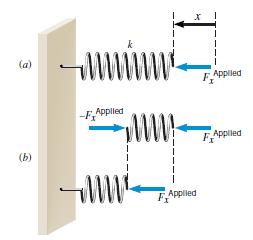Refer to Conceptual Example 2 as an aid in solving this problem. A 100-coil spring has a
Question:
Refer to Conceptual Example 2 as an aid in solving this problem. A 100-coil spring has a spring constant of 420 N/m. It is cut into four shorter springs, each of which has 25 coils. One end of a 25-coil spring is attached to a wall. An object of mass 46 kg is attached to the other end of the spring, and the system is set into horizontal oscillation. What is the angular frequency of the motion?
Conceptual Example 2
Figure 10.3a shows a 10-coil spring that has a spring constant k. When this spring is cut in half, so there are two 5-coil springs, is the spring constant of each of the shorter springs (a) 1/2 k or (b) 2k?
Reasoning
When the length of a spring is increased or decreased, the change in length is distributed over the entire spring. Greater forces are required to cause changes that are a greater fraction of the spring’s initia length, since such changes distort the atomic structure of the spring material to a greater extent.
Answer (a) is incorrect.
When a force Fx Applied is applied to the 10-coil spring, as in Figure 10.3a, the displacement of the spring from its unstrained length is x. If this same force were applied to a 5-coil spring that had a spring constant of 1/2 k, the displacement would be 2x because the spring is only half as stiff . Since this displacement would be a larger fraction of the length of the 5-coil spring, it would require a force greater than FxApplied, not equal to FxApplied. Therefore, the spring constant cannot be 1/2 k.
Answer (b) is correct.
As indicated in Figure 10.3a, the displacement of the spring from its unstrained length is x when a force FxApplied is applied to the 10-coil spring. Figure 10.3b shows the spring divided in half between the fifth and sixth coils (counting from the right). The spring is in equilibrium, so the net force acting on the right half (coils 1–5) must be zero. Thus, as part b shows, a force of −FxApplied must act on coil 5 in order to balance the force FxApplied that acts on coil 1. It is the adjacent coil 6 that exerts the force −FxApplied, and Newton’s action–reaction law now comes into play. It tells us that coil 5, in response, exerts an oppositely directed force of equal magnitude on coil 6. In other words, the force FxApplied is also exerted on the left half of the spring, as part b also indicates. As a result, the left half compresses by an amount that is one-half the displacement x experienced by the 10-coil spring. We conclude, then, that the 5-coil spring must be twice as stiff as the 10-coil spring. In general, the spring constant is inversely proportional to the number of coils in the spring, so shorter springs are stiff er springs, other things being equal.

Step by Step Answer:

Physics
ISBN: 9781119539636
11th Edition
Authors: John D. Cutnell, Kenneth W. Johnson, David Young, Shane Stadler





